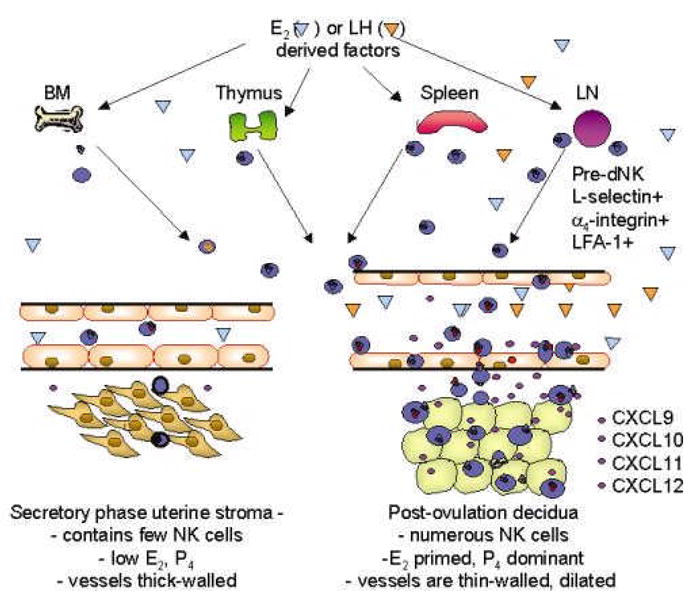Figure 3.

A model of pre-dNK cell trafficking from lymphoid reservoirs to decidualizing uterus. In the early secretory phase and luteal phase of the menstrual cycle, few NK cells ( )enter and leave the uterus in normal immune surveillance. Increased peri-ovulatory plasma concentrations of E2 and/or LH induce expression of unknown factors (
)enter and leave the uterus in normal immune surveillance. Increased peri-ovulatory plasma concentrations of E2 and/or LH induce expression of unknown factors ( ) which mobilize NK cell egress from reservoirs into the circulation, particularly LN. NK cells leave the blood in increased numbers and preferentially enter the uterus in response to a gradient of chemokines (CXCR3 and 4 ligands
) which mobilize NK cell egress from reservoirs into the circulation, particularly LN. NK cells leave the blood in increased numbers and preferentially enter the uterus in response to a gradient of chemokines (CXCR3 and 4 ligands  ) secreted by the E2 primed stromal cells in the post ovulatory uterus. L-selectin is shed as they traverse the decidua and localize in decidual cells proximal to blood vessels. P4 acts on E2-primed stroma to initiate decidualization as well as on vascular endothelium to promote NK cell secreted IFNγ thinning of the vessel wall and dilation of the major arteries (Kitaya et al., 2004; Red-Horse et al., 2001; Hanna et al., 2003).
) secreted by the E2 primed stromal cells in the post ovulatory uterus. L-selectin is shed as they traverse the decidua and localize in decidual cells proximal to blood vessels. P4 acts on E2-primed stroma to initiate decidualization as well as on vascular endothelium to promote NK cell secreted IFNγ thinning of the vessel wall and dilation of the major arteries (Kitaya et al., 2004; Red-Horse et al., 2001; Hanna et al., 2003).
